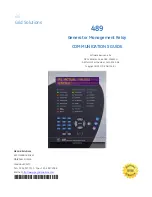
Manual MRIK3-C EN
Woodward
DOK-TD-MRIK3-C Rev. A
71
7.4.11 Test of the CB failure protection
For testing the tripping time a test current of about two times the rated current to be injected. The
timer is started upon tripping of the relay of a protection function (I>, I>>, I
E
> or I
E
>>) and stopped
as soon as the relay for the CB failure protection has picked up. Message "CBFP" is displayed. The
tripping time ascertained by the timer should not deviate more than 1% or, at short trip delay, less
than
10 ms from the set tripping time.
Alternatively, the timer can be started when the aux. voltage and the test current are injected simul-
taneously. The timer stops when the corresponding output relay for circuit breaker failure protection
trips.
In this case the previously measured tripping delay has to be subtracted from the total tripping time
measured.
7.5
Primary
Test
As a rule, tests with currents at the CT primary side (real test) can be performed in the same way
as tests with secondary currents. It is recommended to carry out primary tests only as an exception
and only if it is absolutely necessary (for very essential protective facilities) because in some cases
the costs involved and the strain on the system can be rather high. Many functions of the MRIK3-C
can be checked during normal operation of the system due to the efficient fault and measuring
value indications. So it is possible, for example, to compare the currents shown on the display with
the values shown on the ammeters in the switchboard.
7.6
Maintenance
Normally the relays are checked at regular maintenance intervals at site. From user to user these
intervals may vary because among other things they depend on the type of relay, the kind of appli-
cation, significance of the object to be protected, previous experience of the user etc.
For electro-mechanical or static relays normally an annual check is required. For the MRIK3-C the
maintenance intervals can be much longer because:
The MRIK3-C relays are provided with wide-ranging self-test functions and consequently relay
faults are detected and indicated. It is, of course, imperative that the internal self-supervision
relay is connected to a central display board.
The combined measuring functions of the MRIK3-C make monitoring during operation possible.
The trip test function (TRIP-Test) allows testing of the output relays.
Therefore a maintenance interval of two years is sufficient. When servicing all relay functions incl.
setting values, trip characteristics and tripping times ought to be thoroughly checked.
















































